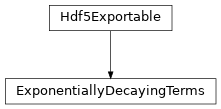ExponentiallyDecayingTerms
full name: tenpy.networks.terms.ExponentiallyDecayingTerms
parent module:
tenpy.networks.termstype: class
Inheritance Diagram

Methods
|
|
|
Add an exponentially decaying long-range coupling. |
Add terms from |
|
Load instance from a HDF5 file. |
|
Maximum range of the couplings. |
|
Export self into a HDF5 file. |
|
Convert self into a |
- class tenpy.networks.terms.ExponentiallyDecayingTerms(L)[source]
Bases:
Hdf5ExportableRepresent a sum of exponentially decaying (long-range) couplings.
MPOs can represent translation invariant, exponentially decaying long-range terms of the following form with a single extra index of the virtual bonds:
\[sum_{i < j} lambda^{|i-j|} A_i B_j\]For 2D cylinders (or ladders), we need a slight generalization of this, where the operators act only on a subset of the sites in each unit cell, given by a 1D array subsites:
\[strength sum_{i < j} lambda^{|i-j|} A_{subsites[i]} B_{subsites[j]}\]Note that we still have
|i-j|, such that this will give uniformly decaying interactions, independent of the way the MPS winds through the 2D lattice, as long as subsites is sorted. An easy example would be a ladder, where we want the long-range interactions on the first rung only,subsites = lat.mps_idx_fix_u(u=0), seemps_idx_fix_u().- Parameters:
L (int) – Number of sites.
- exp_decaying_terms
Each tuple
(strength, opname_i, opname_j, lambda, subsites, opname_string)represents one of the terms as described above; seeadd_exponentially_decaying_coupling()for more details.- Type:
list of tuples
- add_exponentially_decaying_coupling(strength, lambda_, op_i, op_j, subsites=None, op_string='Id')[source]
Add an exponentially decaying long-range coupling.
\[strength sum_{i < j} lambda^{|i-j|} A_{subsites[i]} B_{subsites[j]}\]Where the operator A is given by op_i, and B is given by op_j. Note that the sum over i,j is long-range, for infinite systems beyond the MPS unit cell.
- Parameters:
strength (float) – Overall prefactor.
lambda (float) – Decay-rate
op_i (string) – Names for the operators.
op_j (string) – Names for the operators.
subsites (None | 1D array) – Selects a subset of sites within the MPS unit cell on which the operators act. Needs to be sorted.
Noneselects all sites.op_string (string) – The operator to be inserted between A and B; for Fermions this should be
"JW".
- add_to_graph(graph, key='exp-decay')[source]
Add terms from
onsite_termsto an MPOGraph.- Parameters:
graph (
MPOGraph) – The graph into which the terms fromexp_decaying_termsshould be added.key (str) – Key to distinguish from other states in the
MPOGraph. We find integers key_nr and use(key_nr, key)as state for the different entries inexp_decaying_terms.
- to_TermList(cutoff=0.01, bc='finite')[source]
Convert self into a
TermList.- Parameters:
cutoff (float) – Drop terms where the overall prefactor is smaller then cutoff.
bc ("finite" | "infinite") – Boundary conditions to be used.
- Returns:
term_list – Representation of the terms as a list of terms. For “infinite” bc, only terms starting in the first MPS unit cell are included.
- Return type:
- classmethod from_hdf5(hdf5_loader, h5gr, subpath)[source]
Load instance from a HDF5 file.
This method reconstructs a class instance from the data saved with
save_hdf5().- Parameters:
hdf5_loader (
Hdf5Loader) – Instance of the loading engine.h5gr (
Group) – HDF5 group which is represent the object to be constructed.subpath (str) – The name of h5gr with a
'/'in the end.
- Returns:
obj – Newly generated class instance containing the required data.
- Return type:
cls
- save_hdf5(hdf5_saver, h5gr, subpath)[source]
Export self into a HDF5 file.
This method saves all the data it needs to reconstruct self with
from_hdf5().This implementation saves the content of
__dict__withsave_dict_content(), storing the format under the attribute'format'.